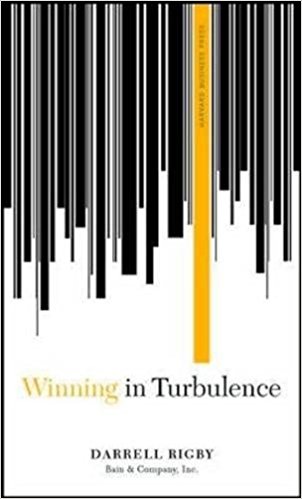Winning in Turbulence Summary

4 min read ⌚
 Think of your company as an airplane flying through turbulence. Just like air pilots, executives and company leaders flying through the turbulent economy, have to try hard to keep the company “in the air.”
Think of your company as an airplane flying through turbulence. Just like air pilots, executives and company leaders flying through the turbulent economy, have to try hard to keep the company “in the air.”
Who Should Read “Winning in Turbulence”? And Why?
The narrative focuses on actual steps that companies of any size and industry can use to tackle the problems they face. Although the book is small and the language is at times vague, the structure of the book is very understandable.
Each part presents clear and usable recommendations, examples, anecdotes, questions, and tools. For all those reasons, we recommend “Winning in Turbulence” to executives and company leaders that deal with uncertainty and turbulence in their business environment.
About Darrell Rigby
 Darrell Rigby leads Bain & Company’s Global Retail practice. He is also a Partner in the company’s Boston office.
Darrell Rigby leads Bain & Company’s Global Retail practice. He is also a Partner in the company’s Boston office.
As a writer, Rigby mainly focuses on topics about managing businesses in a downturn. He is a frequent speaker on the same subject and has authored many Harvard Business Review articles.
“Winning in Turbulence Summary”
The most important thing if your company is experiencing a crisis is to survive – at any cost. Then again, while trying to survive, your company may bump into some new, unexpected opportunities. Your firm’s potential and capability to find new possibilities to develop, among the hazards, depends on “three critical dimensions”.
First, the industry impact, or how the crises affect your company’s industry. Second, the strategic position in the industry, or the status of the company as a market leader or a follower. And third, its financial strength, since more finances give you more options to maneuver.
The mentioned three dimensions are determinants of what actions you’ll need to take in a time of recession. Even if your company is part of a recession-sensitive industry, you may have some choices to pick from.
For example, if your business is in a sound position financially and strategically, you can find ways to grow in a harsh environment. To make the most of the situation, you have to assess your status carefully and understand where you stand.
That is how you will know if you should focus on internal growth, on forming strategic partnerships, or on something else.
Equally important as evaluating your financial and strategical stance, is the need to realize that you have to choose your focus point. In turbulent times you have to narrow your attention to the most critical business activities.
Doing so may be the thing that keeps your company “alive” in the end. Manage the complexity of your products and processes. The more straightforward they are, the faster you’ll be able to respond to demand slumps.
First, sketch out what your company would be like if it handled just one service or product. Next, go more in-depth by adding more details and variety. All the while, pay attention to the cost and complications each step adds and at what time complexity becomes a problem.
In the same fashion that you assess your products and processes, you should also make a judgment about your employees. Try to decide which functions are invaluable to the profit-generating staff.
Thereupon, turn to outsourcing and automation, and drop redundant functions. Additionally, manage your company’s cash flows. Study all parts of the cash flow cycle and create your tactics by first learning all you can about your competitors.
Adjust your processes and cash flows according to the environment you are operating in. And last, but not least, aim at maintaining and growing your base of loyal customers.
Practices have shown that businesses that have the support of devoted and unwavering clients, successfully preserve their business even in times of recession.
Key Lessons from “Winning in Turbulence”
1. The Recession Response “Toolkit”
2. Turbocharge sales
3. Putting it to Work
The Recession Response “Toolkit”
The recession response toolkit consists of four steps.
- “Clarify strategy and shift resources to core business activities.”
Protect and strengthen your primary business. Focus on loyal and vital customers and processes. Sell assets that are not essential to let reserves lose.
- “Aggressively manage costs and cash flow.”
Reduce your company’s complexity by streamlining administrative functions and reforming the supply chain. Pay particular attention to cash flow.
- “Increase revenue and margins.”
Use pricing to your advantage. Try to sell more by motivating employees and making improvements to your sales model.
- “Prepare for bold moves.”
Weak markets often carry not only risks but opportunities for acquisitions and partnerships. Use them to gain better strategical position and survive the rough economy.
Turbocharge sales
In times of uncertainty, getting income is more critical than ever. So, motivating the company’s sales force and focusing on your leading customers is a logical step to take. You can do this by targeted offerings, performance management, refined procedures, etc.
Your most important customers in a weak economy are those who in all likelihood will continue buying from you. All in all, try to be flexible and explore new methods to expand your selling network.
Putting it to Work
Companies fail when faced with turbulence because of their inability to change and adapt to the unstable environment. Firms should monitor the situation and respond accordingly, either by focusing on core business, by spotlighting loyal customers or by restructuring.
What differentiates successful companies from unsuccessful ones is how they respond to challenges. Only if the company can go through the crisis and pick up again after it has passed, it can make it in this unstable, competitive world.
Like this summary? We’d Like to invite you to download our free 12 min app, for more amazing summaries and audiobooks.
“Winning in Turbulence” Quotes
The goal of strategy in a downturn is to help you end up on the right side of the mortality tables. Share on X High-potential customers are the hot spots in an otherwise cooling economy. Share on X Pricing decisions made now are likely to affect customers’ perceptions for a long time to come. Share on X Strengthening the organization is one of the most powerful levers any company can pull to improve its performance in a downturn. Share on X Within a given industry, not every company suffers equally. A company’s prospects depend heavily on its strategic position. Share on XOur Critical Review
Businesses that are in the midst of turbulent economy, more than everything need advice that they can put into practice.
This book is just that: a practical guide to survival in times of recession and weak markets.








